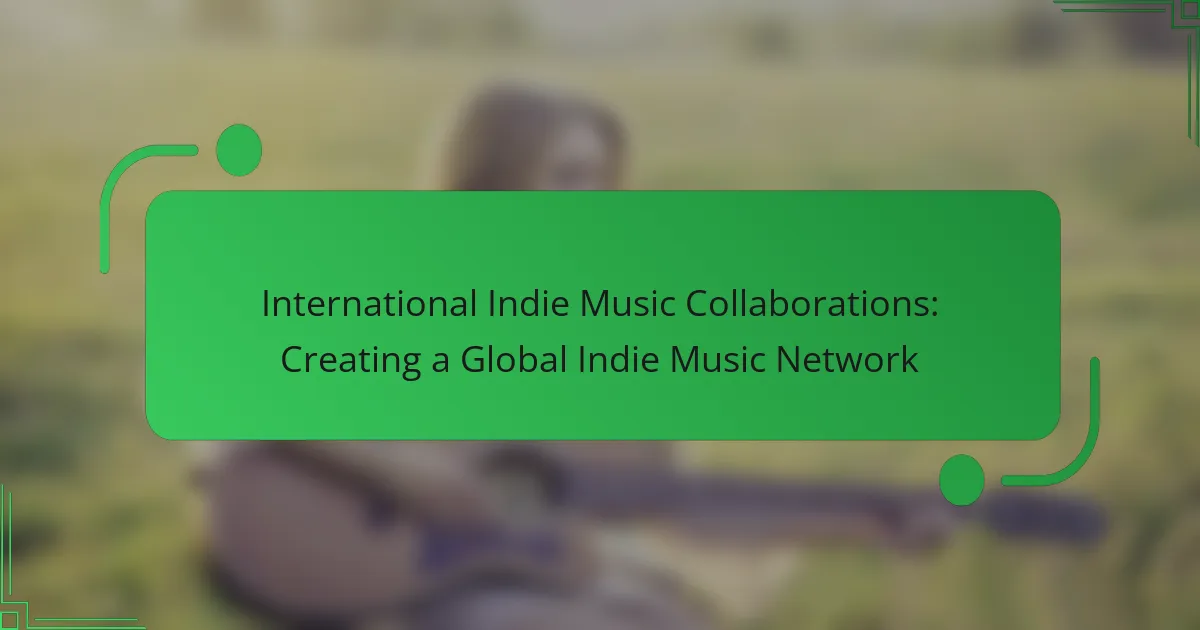International indie music collaborations are revolutionised by technology, enhancing creativity and expanding global reach. Digital platforms enable seamless communication and remote production, allowing artists to blend diverse influences. Challenges like technological barriers and cultural differences persist, yet innovative tools are paving the way for future collaborations. The evolution of AI, virtual reality, and blockchain will further transform the indie music landscape, promoting fair compensation and immersive experiences.
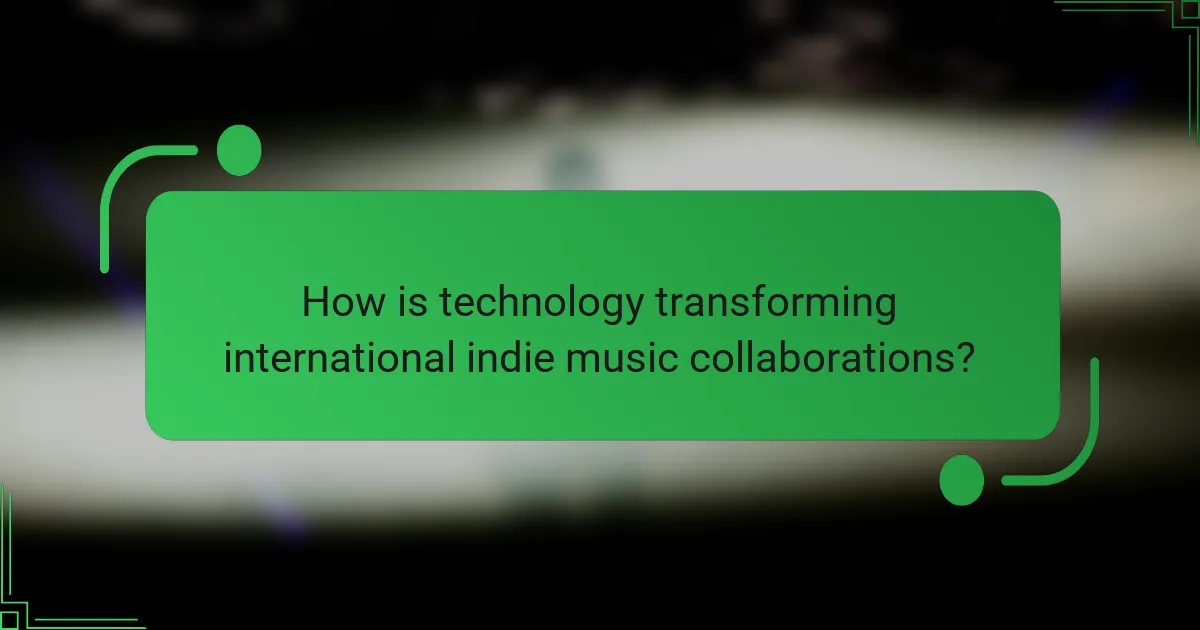
How is technology transforming international indie music collaborations?
Technology is significantly transforming international indie music collaborations by enhancing communication, enabling remote production, and facilitating global distribution. Digital platforms allow artists from different countries to collaborate seamlessly, sharing ideas and resources in real-time. For instance, cloud-based software enables musicians to record, edit, and mix tracks together, regardless of their location. This has led to a rise in diverse musical styles and cross-cultural influences, enriching the indie music scene. Additionally, social media platforms help promote these collaborations to wider audiences, breaking geographical barriers and expanding reach.
What role do digital platforms play in connecting artists globally?
Digital platforms play a crucial role in connecting artists globally by facilitating collaboration and communication. These platforms enable musicians to share ideas, resources, and skills across borders, fostering diverse creative partnerships. For instance, tools like cloud-based digital audio workstations allow artists to produce music together in real-time, regardless of location. This technology not only enhances the quality of collaborations but also broadens the reach of indie music, making it accessible to a global audience. As a result, artists can tap into new markets and fan bases, driving innovation in the music industry.
Which tools are essential for remote music production?
Essential tools for remote music production include digital audio workstations (DAWs), audio interfaces, collaboration platforms, and virtual instruments. These tools enable seamless collaboration across distances, enhancing creativity and efficiency.
| Tool | Purpose | Key Feature |
|————————–|——————————————-|———————————|
| Digital Audio Workstation | Recording and editing music | Multi-track recording |
| Audio Interface | Connecting instruments to computer | High-quality audio conversion |
| Collaboration Platform | Real-time communication and file sharing | Cloud storage |
| Virtual Instruments | Software-based sound generation | Wide range of sounds available |
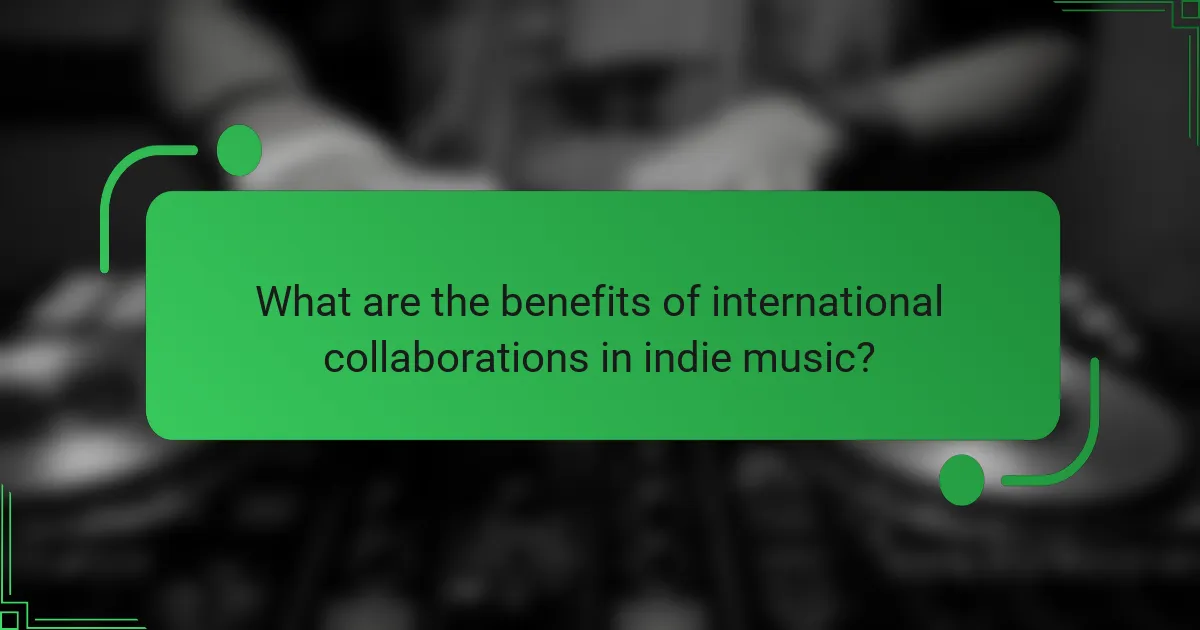
What are the benefits of international collaborations in indie music?
International collaborations in indie music enhance creativity, expand audiences, and foster innovation. Technology plays a crucial role by enabling seamless communication and collaboration across borders. Artists can share ideas and resources, leading to unique soundscapes that blend diverse influences. This cross-cultural exchange not only enriches the music but also promotes mutual understanding among artists and fans. As a result, indie music thrives in a global marketplace, reaching listeners who appreciate varied musical expressions.
How do diverse influences enhance musical creativity?
Diverse influences significantly enhance musical creativity through international indie music collaborations. Technology facilitates seamless communication and sharing of ideas across borders. This collaborative approach leads to unique soundscapes that blend various cultural elements. Artists can experiment with different genres and styles, resulting in innovative music production. For example, digital audio workstations enable artists from different countries to co-create in real-time, expanding their creative horizons.
What economic advantages do artists gain from global partnerships?
Artists gain significant economic advantages from global partnerships through expanded audiences, diverse revenue streams, and collaborative innovation. These collaborations leverage technology for music production, allowing artists to access international markets and engage with fans worldwide. As a result, artists can increase their visibility and income potential. Additionally, partnerships foster creative exchanges that enhance artistic growth and lead to unique musical offerings. This synergy often results in higher-quality productions that resonate across cultural boundaries, further driving economic benefits.
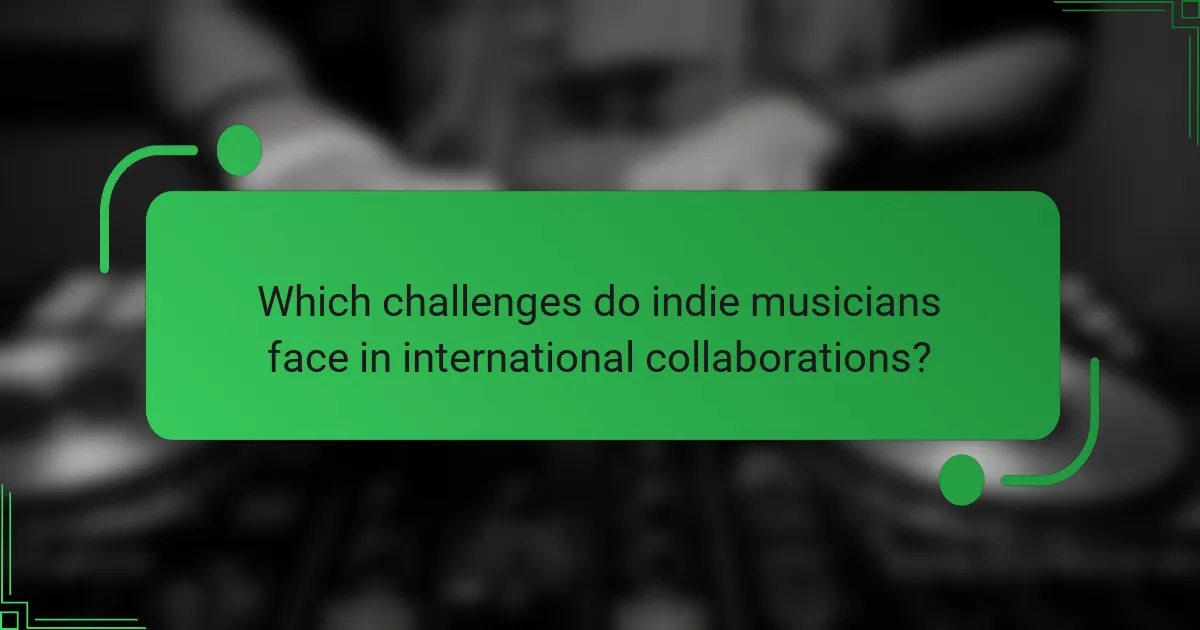
Which challenges do indie musicians face in international collaborations?
Indie musicians face several challenges in international collaborations, primarily due to technological barriers. These include issues with communication, differing music production standards, and access to resources.
Technological limitations can hinder real-time collaboration, making it difficult to synchronise efforts across time zones. Additionally, varying internet speeds can affect the quality of audio and video exchanges.
Cultural differences also pose challenges, as musicians may have different approaches to creativity and production. Navigating these differences requires flexibility and open-mindedness.
Lastly, financial constraints can limit access to high-quality production tools and platforms, impacting the overall quality of the collaboration.
How do cultural differences impact music production?
Cultural differences significantly influence music production in international indie collaborations. These differences shape creative choices, instrumentation, and production techniques. For example, varying cultural backgrounds can affect lyrical themes, sound preferences, and collaborative dynamics. Technology facilitates these collaborations, enabling artists to share ideas and work across distances, yet cultural nuances remain paramount in shaping the final sound. Understanding these differences enhances the richness and diversity of the music produced.
What are common technical issues encountered during remote collaboration?
Common technical issues in international indie music collaborations include poor internet connectivity, software compatibility problems, latency in audio transmission, and difficulties in file sharing. These challenges can hinder effective communication and collaboration among artists. For example, high latency can disrupt real-time music production sessions, leading to frustration and decreased productivity. Additionally, varying time zones can complicate scheduling, impacting collaboration timelines. Addressing these issues requires reliable technology and clear communication strategies.
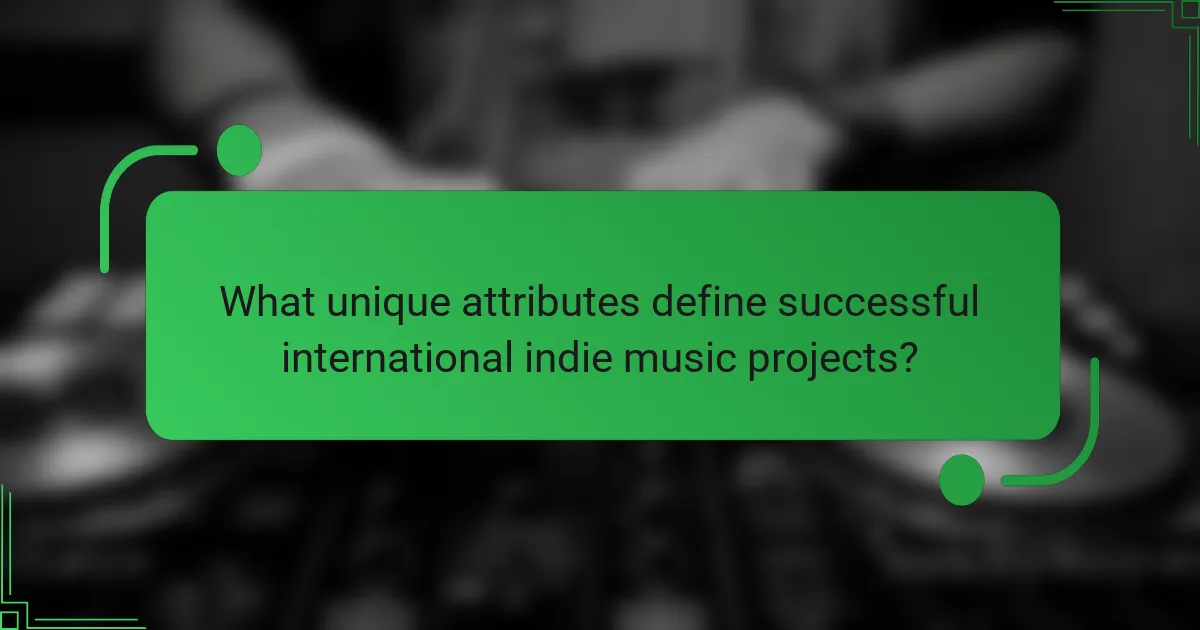
What unique attributes define successful international indie music projects?
Successful international indie music projects often leverage technology to enhance collaboration and creativity. Key unique attributes include cross-cultural influences, innovative production techniques, and global distribution strategies. These elements enable artists to reach diverse audiences and create unique soundscapes. Additionally, the use of digital tools facilitates real-time collaboration, allowing musicians from different locations to work together seamlessly.
How does genre fusion occur in cross-border collaborations?
Genre fusion in cross-border collaborations occurs through the blending of diverse musical styles and cultural influences. Technology facilitates this by enabling remote collaboration and access to various production tools. Artists from different backgrounds can easily share ideas, sounds, and techniques, resulting in innovative music that transcends traditional genre boundaries. For example, digital audio workstations allow seamless integration of instruments and styles from around the world, fostering unique creations. This collaborative process highlights the rare attribute of cultural exchange in music, enriching the global indie music landscape.
What are notable examples of groundbreaking international collaborations?
Notable examples of groundbreaking international collaborations in indie music include projects like “The Silk Road Ensemble,” which unites musicians from various cultures, and “The 1st International Indie Music Festival,” showcasing diverse talents. Technology enhances these collaborations through platforms like SoundCloud and collaborative software, allowing seamless production across borders. The fusion of distinct musical styles creates unique sounds, exemplifying how technology fosters creativity and connection in the global indie music scene.
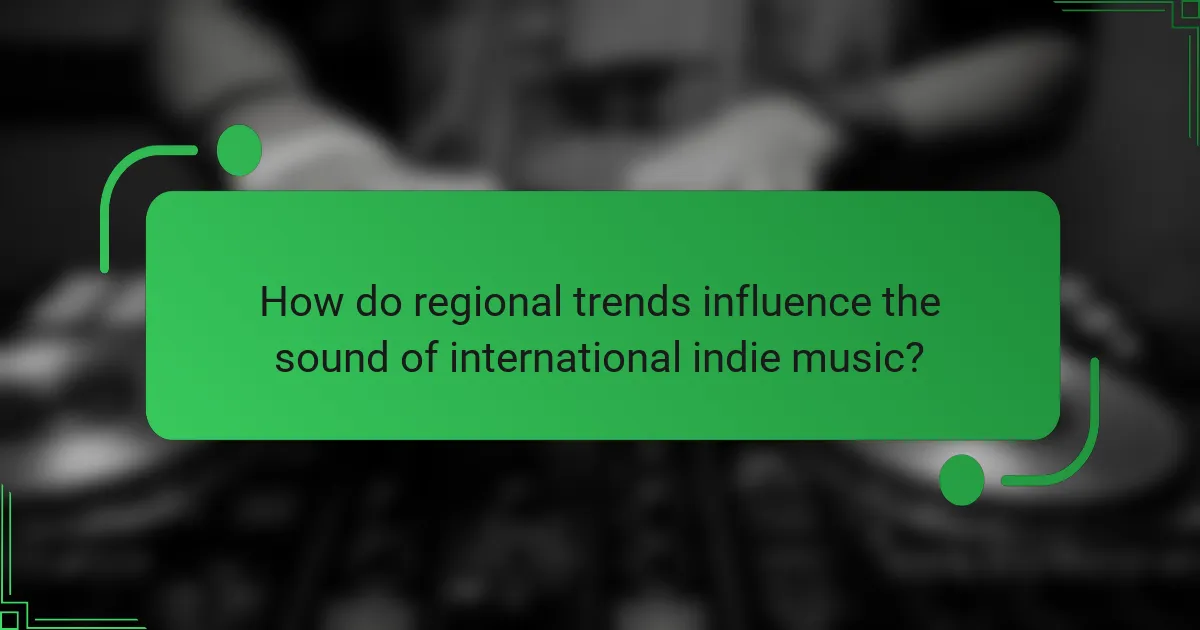
How do regional trends influence the sound of international indie music?
Regional trends significantly shape the sound of international indie music by influencing styles, instrumentation, and lyrical themes. For instance, collaborations often incorporate local musical elements, creating unique fusions. Technology enables artists to access diverse sounds, enhancing cross-cultural exchanges. This blending of regional influences results in innovative genres and expands the global indie music landscape.
Which genres are most popular in specific regions?
International indie music genres vary significantly across regions. In North America, folk and alternative rock dominate, while Europe favours electronic and experimental sounds. Asia showcases diverse influences, with K-pop and J-pop leading in popularity. Latin America often embraces fusion genres, blending traditional styles with modern influences. Africa highlights Afrobeat and highlife, reflecting rich cultural heritages. These regional preferences illustrate how technology facilitates cross-cultural collaborations, shaping global music trends.
How do local music scenes shape global collaboration opportunities?
Local music scenes significantly enhance global collaboration opportunities through technology. These scenes foster unique cultural expressions, attracting artists worldwide. Digital platforms enable seamless communication and production, allowing diverse musicians to collaborate despite geographical barriers. For instance, independent artists can share their work via online platforms, leading to innovative cross-cultural projects. As a result, local sounds influence global music trends, creating a rich tapestry of international indie collaborations.
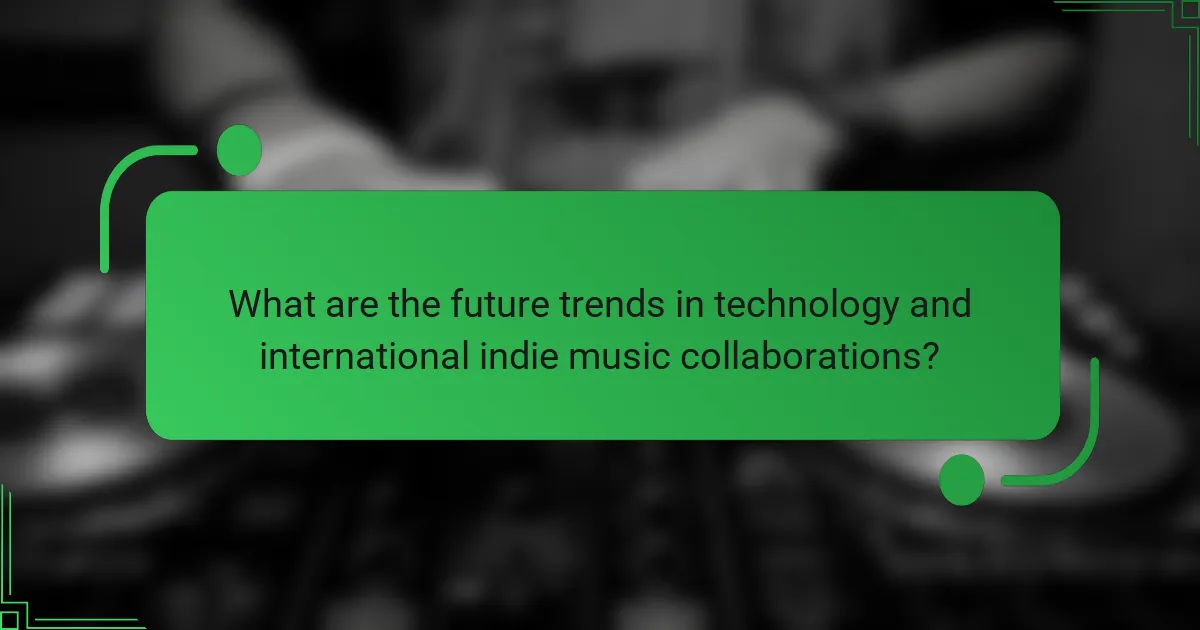
What are the future trends in technology and international indie music collaborations?
Future trends in technology will enhance international indie music collaborations. Innovations like AI-driven music production, virtual reality concerts, and blockchain for rights management will shape these partnerships.
AI tools will facilitate remote collaboration, allowing artists to create unique sounds from different locations. Virtual reality will enable immersive experiences, connecting global audiences with indie musicians. Blockchain technology will ensure fair compensation and transparency in revenue sharing.
As a result, the indie music scene will become more interconnected, fostering diverse musical expressions and cultural exchanges. This technological evolution will empower artists to break geographical barriers and reach wider audiences.
How will emerging technologies like AI affect music production?
Emerging technologies like AI will enhance music production by streamlining collaboration and fostering creativity. AI tools can analyse trends, assist in mixing, and generate unique sounds, enabling artists to innovate. Additionally, cloud-based platforms facilitate international collaborations, allowing musicians to work together seamlessly across borders. AI-driven analytics provide insights into audience preferences, helping artists tailor their music for greater impact. This technology not only improves efficiency but also democratises music production, making it accessible to a wider range of creators.
What predictions can be made about the evolution of global music networks?
The evolution of global music networks will increasingly rely on technology, enhancing international indie music collaborations. Advances in digital platforms enable artists to connect, share resources, and produce music remotely. This shift promotes diverse influences, fostering innovation in sound and style. As a result, we can expect a rise in collaborative projects that transcend geographical boundaries, leading to a richer global music landscape.
What best practices should indie musicians follow for successful collaborations?
Indie musicians should embrace technology for seamless international collaborations. Utilise digital platforms for file sharing and communication to enhance creative exchanges. Leverage software for remote recording and production, ensuring high-quality outputs despite geographical distances. Engage in social media for networking, promoting collaborative projects, and reaching wider audiences. Regularly update skills in music technology to stay competitive and innovative in collaborations.



